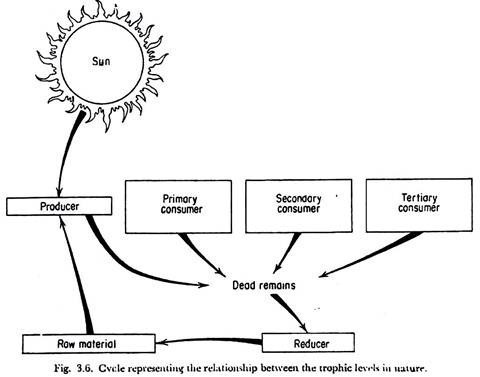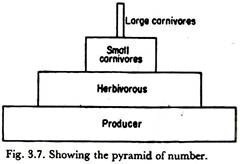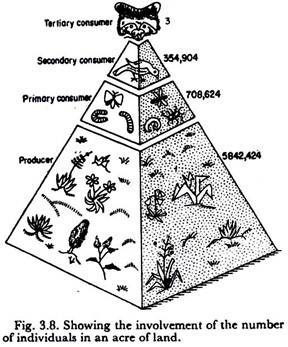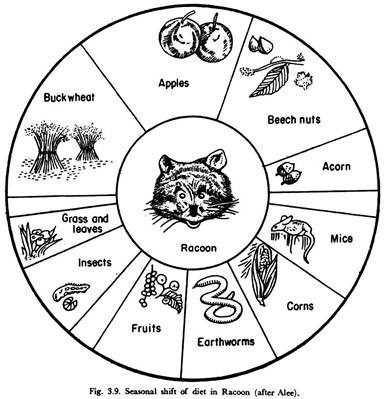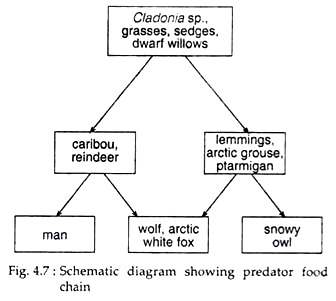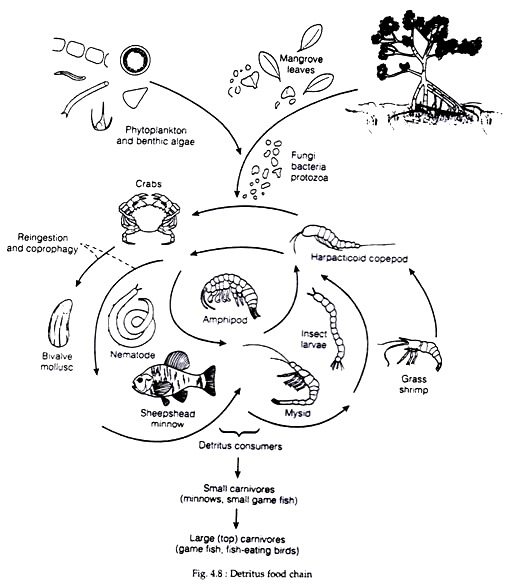In this article we will discuss about:- 1. Definition of Food Chain 2. Components of Food Chain 3. Features 4. Principles 5. Types.
Definition of Food Chain:
Food chains are more or less familiar to everyone in a vague sort of way. It may be because man occupies a position at or near the end of a chain of food items. If occupies an intermediate trophic position between primary and secondary consumers.
The inter-relationship between plants and animals and between animals and animals in the sphere of energy production and consumption results in a definite pattern of several stages of eating and being eaten up — this is referred to as the food chain.
Any habitat, if it is habitable, contains both autotrophs and heterotrophs. The autotrophs depend on raw materials of the habitat and heterotrophs are dependent directly or indirectly upon autotrophs.
ADVERTISEMENTS:
These relationships pertaining to the nutritional factor form a. food series or food chain. The food chain is never a closed circuit but bears many ramifications.
Several trophic levels form the knots in a food chain. The producer elements or autotrophic biota form the very foundations of a food chain. These photosynthetic organisms must exist if other levels are to be maintained.
Other trophic levels of the food chain consist of consumer elements. The consumer elements include a group of organisms having diverse food habit and preference. Herbivores, carnivores, omnivores, parasites, saprozoics are all included in the consumer elements.
Any consumer that is dependent upon the producer elements for its food is called a primary consumer. The next step in the food chain is occupied by secondary consumers. Secondary consumers are dependent upon the primary consumers. A step above this remains occupied by tertiary consumers.
ADVERTISEMENTS:
Thus a survey of a food chain reveals the position of an organism in a food chain. The final consumer in a food chain will eventually die due to old age, injury, disease or any other factor. The producers, consumers and the waste products of the consumers finally become exposed to the final elements of the food chain.
These final elements are the decomposers or reducers. The decomposers transform the dead organic matters into raw materials which are used again by the ‘producer elements of the food chain (Fig. 3.6).
The food chain or the web of relations between different organisms is a very complex one. Let us disentangle a food chain with the help of an example. In any open woodland there are many grass, herbs and trees. These are the producer elements.
ADVERTISEMENTS:
Aphids that live in the wood- -land feed on the producer elements. The aphids thus are primary consumers. Birds that live in this woodland feed on the primary consumers or aphids and thus are secondary consumers. The hawks that may live in the woodland feed on these birds and thus form the tertiary consumers. The food sequence is thus represented by: Hawks → Birds → Aphids → Plants.
Components of Food Chain:
A food chain is basically made up of producers and consumers. The producers are represented primarily by the green plants, and, to a lesser extent, by the photosynthetic bacteria. The consumers include all the other types of organisms in the ecosystem like herbivores, carnivores etc. Since most other prominent types of animal life depend upon the herbivores, they have been referred by Elton (1939) as “key industry animals”.
Producers → Primary consumers (herbivores) → Secondary consumers (primary carnivores) → Tertiary consumers (Secondary carnivores) → etc.
Common Features of Food Chain:
(i) Plants lie at the foundation of all food chains:
This is because of the fact that plants are the only organisms that can manufacture their own food.
(ii) Food chains are of complicated nature:
A variety of food is used by the animals. Thus each chain has many side branches. Each branch divides and subdivides giving the food chain a very complex appearance. Hardy has established the minute details of the complexity of the food chain from the study of the life cycle of herring. When ½ to ¼ inch in length, the young herrings feed on diatoms, larvae of molluscs and crustacean copepods.
At the same time they are preyed upon by the jellyfishes. When the herrings are ½ to 1⅓ inches in length, they feed mainly on cope- pods and at this stage they are not preyed upon by the jellyfishes. In the next stage of its life (length about 5 inches) its food habit changes slightly but food preference becomes wider. Invertebrate predators cannot take them as their prey at this stage.
From this stage onward and uptil the attainment of adulthood the fishes switch over from copepods to young sand eels, larger crustaceans and tunicates (Oika- pleura). Thus at the different stages of the life history of herring a complex relationship appears between predator with predator, prey with prey, the base in each case is, however, a plant.
ADVERTISEMENTS:
(iii) The link in a food chain varies from 3-5:
The number of links in a food chain are usually three and very seldom it exceeds five. As we climb up a food chain we find that the size of the predators progressively increases. Finally, a stage is reached when the predator becomes so large in size that it can no longer be preyed upon. The possible link is thus dependent upon the magnitude of the increase in size in the steps.
(iv) There is a progressive increase in number from top to bottom of a food chain (Fig. 3.7) and a progressive increase in the size of predators from bottom to top:
At each step of a food chain the size of the predator becomes large and the number become small. The mortality rate among smaller animals is usually higher.
Such a progression or pyramid of number as it is sometimes called is a characteristic feature of all animal communities (Fig. 3.8).
Most animals exhibit fixity in food habit, i.e., they devour similar type of food. But this is not universal in all the cases. Many animals change their food habits according to the availability of food in the area they inhabit. Fig. 3.9 relates the seasonal shift of diet in Racoon.
Principles of Food Chain:
1. The components of a food chain occupy different trophic levels. The producers occupy the first trophic level, the primary consumers the second and so on.
2. A particular organism may often occupy different trophic levels of a food chain. For example, man may either eat the grains or the flesh of goat that feeds on the plant, thereby occupying two different trophic levels at the same time.
3. The shorter the food chain the greater the available energy or the greater the growth of the organism at the end of the chain. At each transfer in the food chain a large proportion (often 80 to 90 percent), of the potential energy is lost as heat. For example, in a pond ecosystem the shorter food chains that exist are:
Phytoplankton → silver carp
Macrophytes → grass carp
4. A number of food chains may exist in the same ecosystem. For example, the following food chains may exist in a grassland ecosystem:
Plant → rodents → snakes → hawks
Plant → goat, sheep, cow → man, foxes
5. Although the energy in a food chain diminishes as we go higher up the food chain, the conversion efficiency of available energy into the protoplasm is greater.
6. In addition to the operation of the second law of thermodynamics, size of food is one of the main reasons, underlying the existence of food chains, as Elton (1927) pointed out. This is because there is definitely an upper and lower limit to the size of food that can efficiently support a given animal type. For example, the difference between predator food chain and a parasite food chain is that, in the latter chain, organisms are smaller and smaller instead of being generally larger and larger.
Types of Food Chain:
Food chains are of two basic types:
A. Grazing food chain, and B. Detritus food chain.
A. Grazing food chain:
It starts from a green plant base, goes to grazing herbivores and on to carnivores. It can be of two types:
(i) Predator food chain, where the sequence of organisms are generally from small to big.
(ii) Parasitic food chain, where organisms tend to decrease in size as one goes higher up the food chain.
Example of a predator food chain:
During the 1920s and 1930s, the pioneer British ecologist Charles Elton studied the ecology of arctic lands. This study can be cited as an example of a predator food chain (Fig. 4.7). The most important producers are the reindeer lichens (Cladonia sp.).
These plants, together with the grasses, sedges and dwarf willows, form the diet of the caribou and of its ecological counterpart, the reindeer. These animals, in turn, are preyed upon by the wolves and humans.
Further, the tundra plants are also eaten by lemmings, ptarmigan (Lagopus lagopus) and arctic grouse (Lagopus mutus). They, in turn, are preyed upon by the arctic white fox (Alopex lagopus), snowy owl (Nyctea scandiaca) and other raptors — throughout the long winter and during the brief summer. Any radical change in the density of Cladonia or in the numbers of rodents drastically affects the trophic levels as the alternative choice of food are few.
Example of a parasite food chain:
Roots of vegetable crops are parasitized by nematodes on which may be attached bacteria or other smaller organism.
Roots of vegetables nematodes → bacteria
Mammals, birds are parasitized by fleas, which, in turn, have protozoan parasites of the genus Leptomonas sp.
Mammal, bird → fleas → Leptomonas sp.
Highlights:
1. Both parasites and predators are consumers
2. A parasite of a green plant is herbivorous, whereas animal parasite falls in the various carnivorous categories.
3. Parasitic food chains, on an average, are shorter than predator food chains since the metabolism per gram increases sharply with the diminishing size of the organisms, resulting in a rapid decline in the biomass that can be supported.
B. Detritus food chain:
It passes from dead organic matter to microorganisms and then to detritus feeding organisms (detritivores) and their predators.
Example of detritus food chain:
An example of detritus food chain based on mangrove leaves has been worked out by W. E. Odum and E. J. Heald (1972, 1975). In the brackish zone of southern Florida, leaves of the red mangrove (Rhizophora mangle) fall into the warm shallow water at an annual rate of 9 metric tonnes per hector. Only about 5 percent of the leaf material is grazed upon and the rest is acted upon by microorganisms.
A key group of small animals (meiofauna) comprising of only a few species ingest large quantities of the detritus along with the associated microorganisms and smaller quantities of algae. The meiofauna in estuaries consists of small crabs, shrimps, nematodes, snails, small bivalves etc.
The particles ingested by these detritus consumers pass through the guts of many individual organisms and species in succession (a process of coprophagy) resulting in the extraction and reabsorption of organic matter until the substrate has been exhausted (Fig. 4.8). Small fishes feed upon the detritus consumers and larger fishes, in turn, upon the smaller ones.
Highlights:
1. In nearly all ecosystems some of the net production is consumed as living plant materials and some is consumed later as dead plant materials. Therefore, in all ecosystems, the grazing and detritus food chains are interconnected.
2. The detritus chain ends up in a manner similar to the grazing pathway, but the way in which the two chains begin is quite different.
3. The detritus food chain is more complex, less understood and in many ecosystems the more important.
4. The detritus food chain is more stable in terms of resistance to weather and other perturbations than the grazing food chain.
5. The detritus feeders are a mixed group. Some of them obtain their energy directly from plant material, most of them secondarily from microorganisms and some tertiary through carnivores (that is, by eating protozoa or other small invertebrates that feed on bacteria, which, in turn, have digested plant material).
